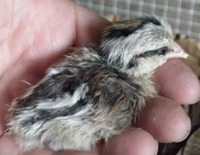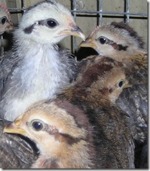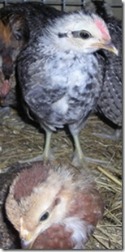Sexing Chicks
Sexing chicks is often necessary if they are to be sold. Selling day old chicks has become very popular as they can be shipped over night, long distances, in fair weather, with little trouble.
Healthy just hatched chicks will have enough fluids and nutrients left over from their 21 day egg yolk diet to travel and keep them well for about 24 hours. Shipping companies, including the U.S. Postal Service, refuse to transport them if the weather is too hot or too cold.
20 or more fluffy chicks in a box with minimal ventilation will keep each other warm enough, but hatcheries are unable to ship just a few.
For the most part, sexing chicks is a process done in large hatcheries by professionally trained veterinary technicians, examining the internal sex organs. If you want to hatch and sell sexed chicks you will have to learn. Another option is to breed sex linked colors.
This is accomplished by crossing a rooster of one breed with hens of another breed and color. In certain combination's, all female chicks will be one color and all male chicks another, making sexing very simple. The other option is to sell chicks “straight run” meaning not sexed, and no guarantees of how many male or female chicks.

Sexing day old chicks is very difficult. The following instructions for sexing chicks are meant mainly as a description of the process, because doing this incorrectly can result in life threatening internal injuries to the chicks.
If you have any doubts about doing this, it’s best to wait until the chicks are older. Bantam chicks are so difficult to sex, due to their small size and the damage potential, that even the large hatcheries sell most Bantams “straight run”.
If you feel confident that you will not harm chicks in the process, have excellent eye sight, believe yourself extremely observant, and think you are ready to practice, go find yourself a few day old chicks, preferably not bantams.
Sexing Chicks: Hold a chick in one hand, firmly but gently with the chick’s rear facing you. In that hand use one finger to separate the legs as you hold it head up. Hold the chick over a sink or other area that can be easily cleaned. Press gently on its abdomen, then gently squeeze its vent with the thumb and first finger of your other hand.
This will clear the vent of feces to make it easier for sexing chicks. You can now carefully spread the vent, using your thumb and index finger, and cause the tissue just inside the vent to be visible.
You may want to use magnifying reading glasses. Sexing chicks at a young age is difficult. If doing this correctly you should see a small protrusion, called a process, in males. It may look button-like, or something like a penis.
Usually the females will have no visible bulge, or just a slight indentation. Some females may have a small bump that looks like a process. However, this bump will often be dull in tone, rather than the shiny surface that indicates a male.
Obvious males should be placed in one box and obvious females in another. Place any chicks in a third box if you are uncertain and repeat the sexing process after you have a little more experience and have checked the whole group. Even professionals at the big hatcheries claim only to be seventy-five percent accurate.
Sharon's Method for Sexing Chicks
In raising chicks over the years I have used my own method, not the above, for sexing chicks. The above method has been explained by someone with experience.
I’ve noticed that within the first weeks of life I can see a difference in the thickness of the legs of chicks. Male chicks, with thicker legs, seem to grow a little faster and soon become taller than the females.
In many bird species, since the pelvic area of the females will pass eggs, the legs are set a little wider apart. In sexing young chickens these comparative methods only work with chicks of the same age and same pure breed.
Mixed breed chicks may have different dominant genes, some from the rooster and some from the hen, and different breeds mature at different rates.
Watching your chicks as they grow can allow you to notice subtle changes, making sexing chicks simple. Young roosters, or cockerels, will develop taller combs that begin turning darker, long before they are fully feathered and start developing long cycle, saddle and tail feathers.

Cockerels will begin developing pointed neck or cape feathers and the young hens or pullet’s neck feathers keep their rounded ends, long before cockerels begin to crow.
These young Bantam Phoenix chicks, just weeks old already display pink and slightly taller combs in the cockerels, while the pullet combs are still yellow and small. The comb becomes taller, as in the last photo, then it begins to change color.

If planning to sell chicks as a small or large business, you will want to become expert at sexing chicks. For this, getting trained by an expert would be best so you are prepared by the time your chicks hatch. Most of us raising chicks for our family farms enjoy watching them grow no matter what sex the chicks are.

How do I know if my chicks are male or female
QUESTION I JUST BOUGHT 6 RED PULLETS FROM MY LOCAL TRACTOR SUPPLY STORE. THERE WERE A BUNCH IN A BARREL & HE JUST PICKED OUT 6. IS THERE A CHANCE THAT I MAY HAVE A MALE (ROOSTER) IN THIS BATCH I JUST BOUGHT?
ANSWER Generally, when buying chicks from a farm supply, and they are called “pullets”, it means they have been sexed as female at hatching. Usually hatcheries guarantee most will be female, not 100%, allowing for the possibility of human error.
Buying “straight run” means no sexing was done, but sometimes dishonest hatcheries will throw their cockerel (male) chicks into this grouping, which highly decreases chances of getting hens. I’ve never learned how to “feather sex” young chickens, but this is a common practice in hatcheries.
When I have raised chicks of the same age and breed, I’ve noticed that the young cockerels show heavier legs in the first few weeks of life. As the chicks grow, the cockerels, eventually being a larger, heavier adult would need bigger stronger legs to support their bodies. This method has never failed me with same age, same breed chicks.
There is always the possibility that chicks are either sex. A few years back, a friend purchased 20 “pullet” chicks from a local farm supply (not Tractor Supply). Her plan was to raise the chicks on an organic diet and be able to sell organic eggs, when they started laying.
She invested in a of ton of organic chicken feed and lovingly raised her chicks. She knew there was the possibility she might get a rooster or two, but ALL turned out to be male. We’ll never know if this was an honest mistake, or laziness on the part of a hatchery employee, or just outright trickery…but it happens.
You could call Tractor Supply and ask what kind of guarantee there is that these chicks are pullets, and keep your receipt, just in case. I’ve always found Tractor Supply stands behind their products and is easy to deal with when there is a problem with merchandise. Hopefully you got all females, if that’s what you want.

Custom Search



New! Comments
Have your say about what you just read! Leave me a comment in the box below.